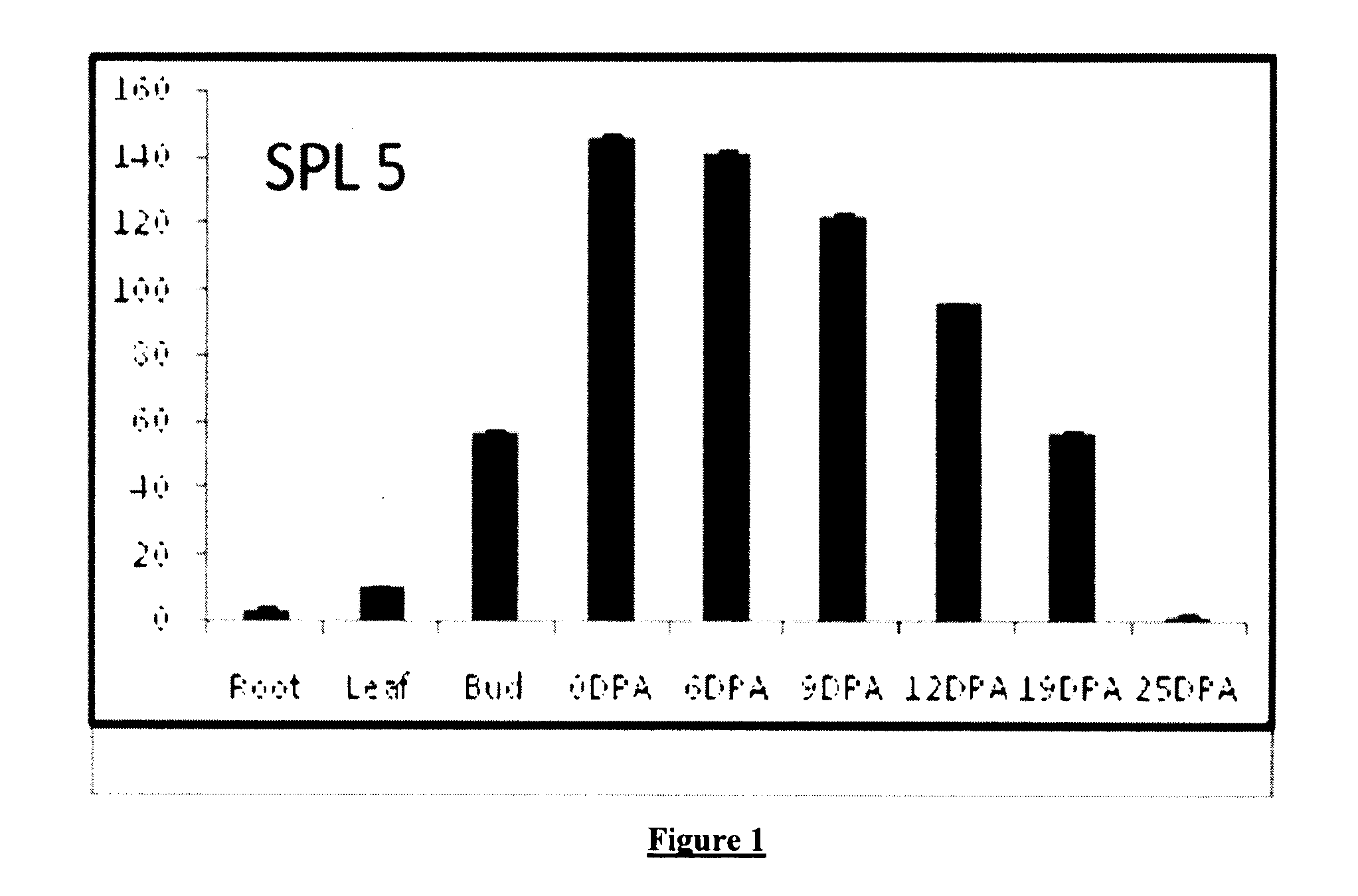Method for production of transgenic cotton plants
- Summary
- Abstract
- Description
- Claims
- Application Information
AI Technical Summary
Benefits of technology
Problems solved by technology
Method used
Image
Examples
example 1
[0094]Expression Analysis of SPL5 Gene at Different Developmental Stages of Cotton
[0095]Total RNA was isolated using RNA isolation kit (Sigma-Aldrich) from field grown Cotton plants (of J.K. Agri-genetics Pvt. Ltd., Hyderabad, India) at different developmental stages namely Root, Leaf, Bud, 0 DPA, 6 DPA, 9 DPA, 12 DPA, 19 DPA, 25 DPA. After DNase I treatment (Ambion), RNA was quantified and checked for the integrity by using a Bioanalyzer 2100 (Agilent, Inc., Palo Alto, Calif., USA). 2 μg of DNase treated RNA was used for cDNA preparation using oligo dT primer by SuperScript® cDNA Synthesis Kit (Invitrogen) in 20 μl. The cDNA products were then diluted 10-fold with deionized water before use as a template in real-time PCR. The quantitative reaction was performed on ABI 7500 Real-Time PCR Detection System (Applied Biosystems) using the SYBR Green PCR Master Mix (Applied Biosystems, CA). The reaction mixture (10 μL) contained 5× SYBR Green PCR Master mix, 1 μl (10 pmol) each of the fo...
example 2
[0096]Construction of Over Expression Module
[0097]Complete SPL5 gene ORF (isolated from cDNA by using primer of sequence I.D. 2) of 549 bp (FIG. 2) was cloned into EcoRV digested SK+ and then sub-cloned into NcoI / BstEII digested pCAMBIA 1301 binary vector. The resultant pCAMBIA 1301 (of Cambia Institute, Canberra, Australia) carrying the Overexpression module was transformed into cotton via Agrobacterium tumefaciens strain GV3101 (DNA Cloning Services; Hamburg, Germany) following the modified protocol (Cangelosi et al., 1991) (FIG. 3).
example 3
[0098]Construction of Knock Down (RNAi) Expression Module
[0099]The 398 bp sequence of SPL5 having AscI and SwaI restriction enzyme site at 5′ end and BamHI and SpeI at 3′ end was cloned into Sk+ vector. The knockdown module of SPL5 was made by first digesting with AscI and SwaI and this fragment was cloned into sense direction and Further to clone into antisense direction the construct was digested with BamHI and SpeI. These sense and antisense fragments were sub-cloned into Binary vector PFGC 1008 (of Arabidopsis Biological Resource Centre, Columbus, USA). The resultant PFGC 1008 carrying the knockdown module was transformed into cotton via Agrobacterium tumefaciens strain GV3101 following the modified protocol (Cangelosi et al., 1991) (FIG. 4).
PUM
| Property | Measurement | Unit |
|---|---|---|
| Size | aaaaa | aaaaa |
| Level | aaaaa | aaaaa |
Abstract
Description
Claims
Application Information
 Login to View More
Login to View More - R&D
- Intellectual Property
- Life Sciences
- Materials
- Tech Scout
- Unparalleled Data Quality
- Higher Quality Content
- 60% Fewer Hallucinations
Browse by: Latest US Patents, China's latest patents, Technical Efficacy Thesaurus, Application Domain, Technology Topic, Popular Technical Reports.
© 2025 PatSnap. All rights reserved.Legal|Privacy policy|Modern Slavery Act Transparency Statement|Sitemap|About US| Contact US: help@patsnap.com



